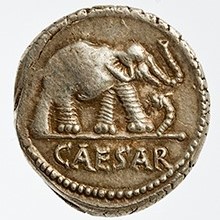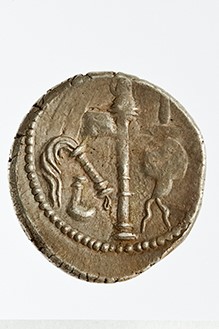Title: Denarius of Julius Caesar - 2007.01
Acquisition number: 2007.01
Author or editor: Beryl Rawson
Culture or period: Roman Republic
Date: 49-48 BC
Material: Metal - Silver
Object type: Coins - Roman
Dimensions: 17mm (w)
Origin region or location: Italy
Origin city: Mint moving with Julius Caesar
Display case or on loan: 5
Keywords: Coin, denarius, Roman, Republic, Julius Caesar
Sear, D.R., Roman Coins and their Values 5 vols (London, Spink, 2000-2014) 1399; Crawford, M., Roman Republican Coinage 2 vols (Cambridge, Cambridge University Press, 2011) 443/1 and pl. LII; Sear, D.R., The History and Coinage of the Roman Imperators (London, Spink, 1998) 9; Grueber, H.A., Coins of the Roman Republic in the British Museum 3 vols (London, The Trustees of the British Museum, 1910; rev. edn London, 1970) Gaul 27; Seaby, H.A., Roman Silver Coins (London, B.A. Seaby, 1967) 49 (Italy 49 BC); Sutherland, C.H.V. and R.A.G. Carson, The Roman Imperial Coinage vol. 6: From Diocletian’s Reform (AD 294) to the death of Maximinus (AD 313) (London, Spink, 1967) pll. 141, 142.
2007.01
Denarius of Julius Caesar
3.99 g. 49-48 BC
Obv.: Elephant r., trampling on serpent or dragon. In exergue, CAESAR.
Rev.: Ceremonial ladle (simpulum), sprinkler (aspergillum), axe (securis), priest’s hat (apex). Border of dots.
Issued from a mint moving with Caesar, in north Italy after his invasion of Italy. Caesar’s first military issue. Hoard evidence helps determine the date.
Interpretations of the obverse vary, e.g. virtue (the elephant/Caesar and his army) overcoming evil. Some think that the dragon represents the carnyx, a Gallic trumpet.
The attributes on the reverse are symbols of the office of pontifex maximus (high priest), held by Caesar since 63 BC. The religious symbols underline the message that Caesar has the gods on his side. The simpulum is the ladle for applying wine in sacrifice. The aspergillum sprinkles holy water. The axe is used in sacrifice. The apex is the conical cap worn by a flamen (priest), named for the rod at its top, wound round with wool.
Sear, D.R., Roman Coins and their Values 5 vols (London, Spink, 2000-2014) 1399; Crawford, M., Roman Republican Coinage 2 vols (Cambridge, Cambridge University Press, 2011) 443/1 and pl. LII; Sear, D.R., The History and Coinage of the Roman Imperators (London, Spink, 1998) 9; Grueber, H.A., Coins of the Roman Republic in the British Museum 3 vols (London, The Trustees of the British Museum, 1910; rev. edn London, 1970) Gaul 27; Seaby, H.A., Roman Silver Coins (London, B.A. Seaby, 1967) 49 (Italy 49 BC); Sutherland, C.H.V. and R.A.G. Carson, The Roman Imperial Coinage vol. 6: From Diocletian’s Reform (AD 294) to the death of Maximinus (AD 313) (London, Spink, 1967) pll. 141, 142.

